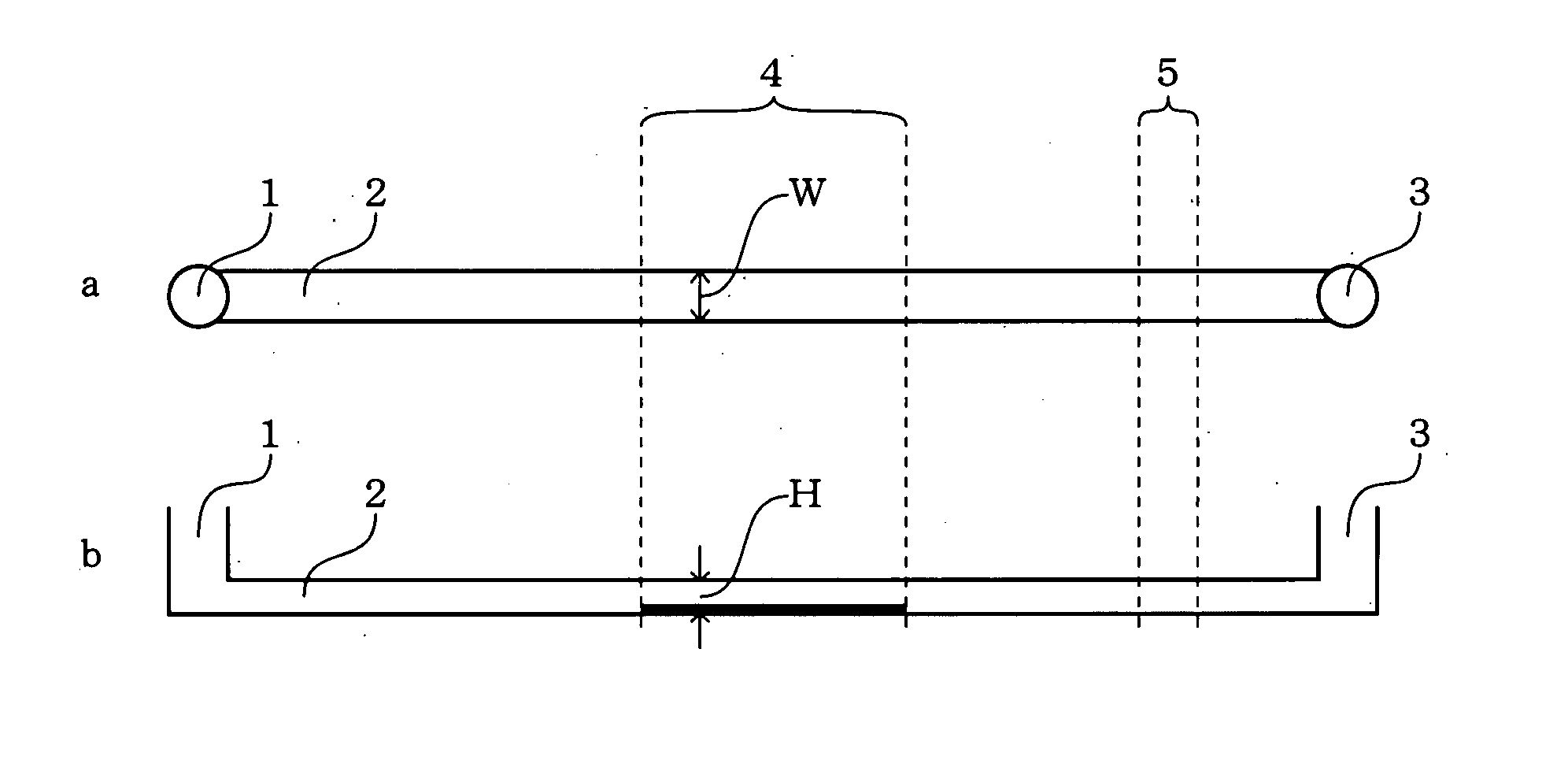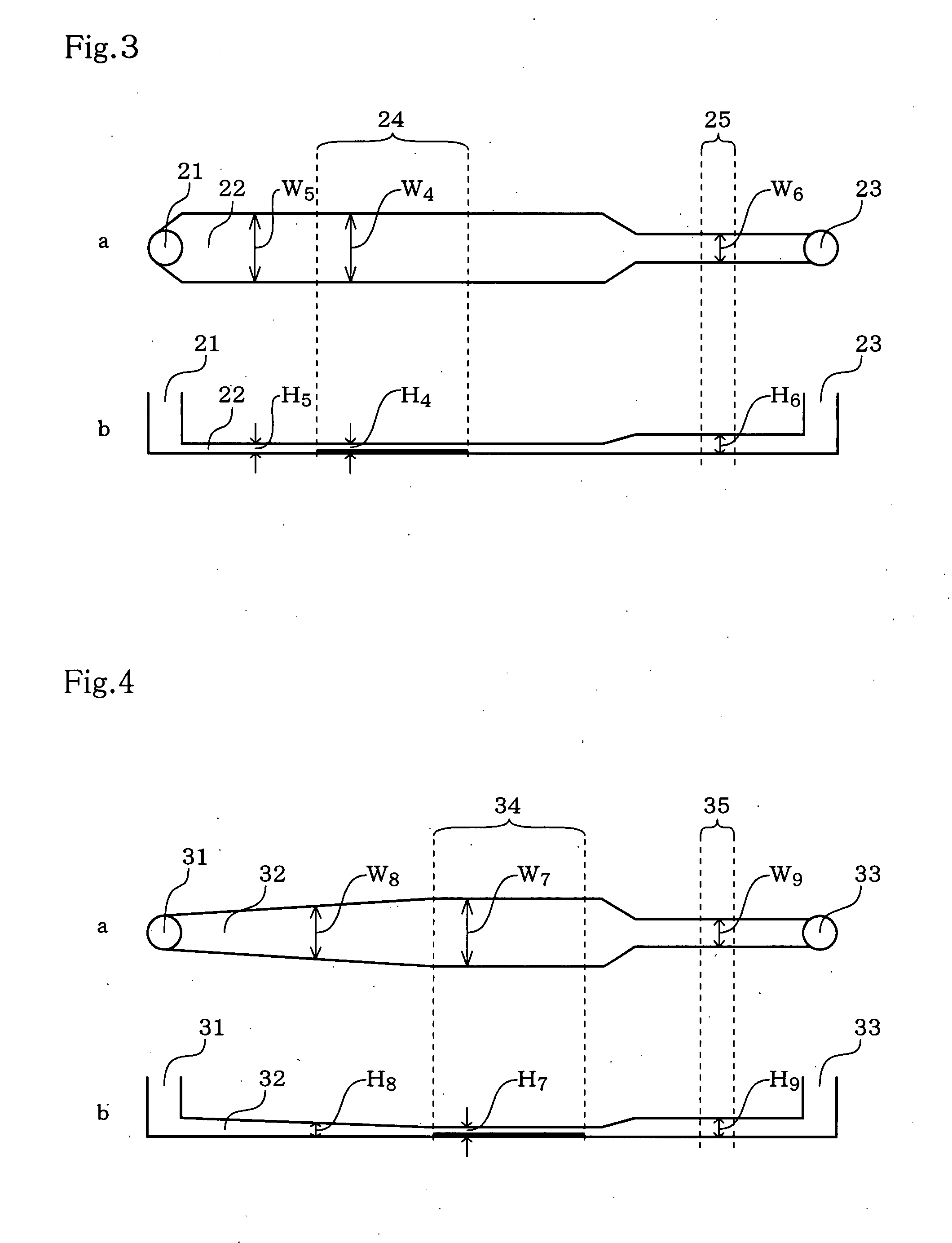Microchip
a microchip and microchip technology, applied in the field of microchips, can solve the problems of weak electrochemical signal reaching the sensor, inability to achieve the improvement of detection sensitivity, and difficulty in accurate control of the flow rate, so as to achieve high detection stability and reproducibility, improve the reaction efficiency in the reaction area, and improve the effect of detection stability
- Summary
- Abstract
- Description
- Claims
- Application Information
AI Technical Summary
Benefits of technology
Problems solved by technology
Method used
Image
Examples
example 1
Preparation of Microchip
(1) Immobilization of DNA
[0070]An oligonucleotide having amino group introduced at its 5′ end and having the sequence of 5′-TTGCTAACCCAGAACACTAT-3′ was synthesized. This oligonucleotide was immobilized on GeneSlide (product name, manufactured by Nihon Parkerizing Co., Ltd.) at positions corresponding to the reaction area along the flow path according to the instruction of the manufacturer.
(2) Preparation of Flow Path and Preparation of Microchip
[0071]Two plates each formed with a groove were prepared by using polydimethylsiloxane (PDMS) plates having a thickness of 1 mm. One plate was formed with a groove corresponding to the standard-type flow path as described in (i), below as a contrast. The other plate was formed with a groove corresponding to the flow path of the present invention as described in (ii), below. The grooves were formed according to the method described in McDonald, J. C. et al., Electrophoresis, Vol. 21, No. 1, 2000, pp. 27-40.
[0072]The two...
example 2
Comparison of Detection Sensitivity Between the Flow Paths of Different Designs: Detection of a Nucleic Acid
[0077]A microchip having a standard-type flow path (with a flow path depth in the reaction area of 0.1 mm and the flow path depth in the detection area of 0.1 mm) and the microchip having a flow path according to the present invention (with a flow path depth in the reaction area of 0.02 mm and a flow path depth in the detection area of 0.1 mm) were compared for their detection sensitivity of the target nucleic acid.
[0078]The target nucleic acid was detected by a microfluid system as follows. An oligonucleotide modified at its 5′ end with biotin and having a sequence complementary to the sequence of the immobilized oligonucleotide was used for the target nucleic acid. More specifically, the flow path of the microchip was filled with BlockAce (product name, manufactured by Snow Brand Milk Products Co., Ltd.) which had been diluted twice with PBS(−) containing 1 mM EDTA and 0.05%...
example 3
Comparison of Detection Sensitivity Between the Flow Paths of Different Designs: Detection of a Protein
[0080]A microchip having a standard-type flow path (with a flow path depth in the reaction area of 0.1 mm and the flow path depth in the detection area of 0.1 mm) and the microchip having a flow path according to the present invention (with a flow path depth in the reaction area of 0.02 mm and a flow path depth in the detection area of 0.1 mm) were compared for their detection sensitivity of the target protein.
[0081]Detection was conducted by using a surface antigen of hepatitis B virus (HBsAg, manufactured by Meiji Dairies Corporation) for the target protein. More specifically, the flow path of the microchip was filled with BlockAce (product name, manufactured by Snow Brand Milk Products Co., Ltd.) which had been diluted twice with a washing buffer, and the microchip was incubated at room temperature (unless otherwise noted, all reactions were hereinafter conducted at room tempera...
PUM
| Property | Measurement | Unit |
|---|---|---|
| width | aaaaa | aaaaa |
| width | aaaaa | aaaaa |
| depth | aaaaa | aaaaa |
Abstract
Description
Claims
Application Information
 Login to View More
Login to View More - R&D
- Intellectual Property
- Life Sciences
- Materials
- Tech Scout
- Unparalleled Data Quality
- Higher Quality Content
- 60% Fewer Hallucinations
Browse by: Latest US Patents, China's latest patents, Technical Efficacy Thesaurus, Application Domain, Technology Topic, Popular Technical Reports.
© 2025 PatSnap. All rights reserved.Legal|Privacy policy|Modern Slavery Act Transparency Statement|Sitemap|About US| Contact US: help@patsnap.com



